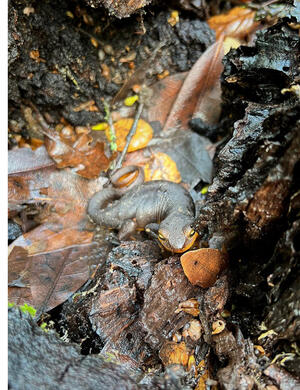UC Berkeley’s Division of Biological Sciences hosted a series of immersive outings to expose alumni, supporters, and friends to some of Berkeley’s top researchers and most memorable research subjects, including rare wildlife, famous brain samples, fluorescent worms, and experimental produce.

A California newt. (Photo by Rebecca Tarvin)
Newts on the Move
Professor Rebecca Tarvin | March 19
The first event of the season began on a cool, misty morning in a muddy section of Briones Regional Park — the perfect setting to witness the great California newt migration. Every March, these rare amphibians make an epic journey (at least for them) to nearby ponds for mating season.
Assistant Professor Rebecca Tarvin brought the group to the same cattle pond her lab group uses for fieldwork. No longer forced to awkwardly trudge forth on tiny legs, the newts swam dexterously through the overflowing waters, rolled around in crowded mating balls, and produced semi-translucent globs of eggs — a veritable paradise of slime!
Tarvin’s research focuses on interesting adaptations, such as the California newt’s ability to produce the deadly toxin tetrodotoxin with bacteria living on its skin. Biologists are attempting to determine if and how many of the newt’s ecological neighbors, like the Pacific chorus frog, have developed resistance to the toxin. Not only were the orange-bellied newt sightings plentiful, but the biology and animal enthusiasts in attendance could pose questions to one of the foremost experts on such toxic species.
Biology of Wellness
Professor Daniela Kaufer | April 29

 Brain slices from Albert Einstein in microscope slides. (UC Berkeley photo by Ryan Guasco)
Brain slices from Albert Einstein in microscope slides. (UC Berkeley photo by Ryan Guasco)






